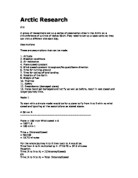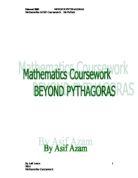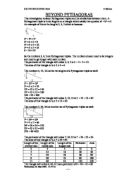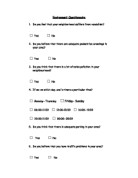A group of researchers set up a series of observation sites in the Arctic on a circumference of a circle of radius 50km.They need to set up a base camp so they can visit a different site each day.
Arctic Research Aim A group of researchers set up a series of observation sites in the Arctic on a circumference of a circle of radius 50km.They need to set up a base camp so they can visit a different site each day. Assumptions These are assumptions that can be made. . Altitude 2. Weather conditions 3. Air resistance 4. Plane speed constant 5. Wind speed constant throughout/No gust/Same direction 6. Time for turning around 7. Time for taking off and landing 8. Rotation of the Earth 9. Weight of fuel 0. Thermal 1. Safety 2. Breakdowns (damaged plane) 3. Plane could get damaged and not fly as well as before, result in less speed and longer journey time. Model 1 To start with a simple model would be for a plane to fly from A to B with no wind speed and ignoring all the assumptions as stated above. A 50 km B --------------------------------------------------------------------- Plane = 100 mph Wind speed = 0 = 100*1.6 = 160 kmh-1 Time = Distance/Speed = 50/160 = 18.75 minutes For the whole journey A to B then back to A would be: Time from A to B multiplied by 2. 2*18.75 = 37.5 minutes Equation Time (A to B to A) = 2(Distance/Speed) OR Time (A to B to A) = Total Distance/Speed Model 2 . Base at centre of the 360 degree circle 2. Wind speed 25kmh from the west 3. Plane travelling at a different speeds but with the same resultant (100kmh) 4. Same
Investigate different shapes of guttering for newly built houses.
Introduction For my maths coursework I was required to investigate different shapes of guttering for newly built houses. The purpose of guttering is to catch as much water running of the roof as possible. The guttering for newly built houses needs to have as large an area as possible so it can hold as much rainwater as possible. For the purpose of this investigation the material used for the production of the guttering will have a fixed width of 30cm. I will be investigating 6 different shapes: * Triangle * Rectangle * Square * Semi-circle * Half-octagon * Trapezium Task Guttering A firm has been asked to make guttering for newly built houses. Investigate Plan To investigate which type of shape will hold the maximum amount of water, I will be calculating the area of the cross-section of each different type of guttering. If possible, I will be changing the variables until I find the maximum area for each shape, the variables being length of sides and size of angles. I will then compare the highest values of each shape and pick the one with the maximum area. Formulas Triangle Area = 1/2 a?b?sin c Rectangle Area = a?b Square Area = l?h Semi-circle Area = 1/2?? ?r² Half-octagon Area = divide the shape into triangles, work out the area of each triangle and then add them together Trapezium Area = 1/2 (a+b)?h Triangle In the case of the
Graphs of Sin x, Cos x; and Tan x
Graphs of sinx°, cosx° and tanx° Here are the sketch graphs of the trigonometric functions f(x) = sinx°, f(x) = cosx° and f(x) = tanx°. You may be asked to draw or sketch these graphs in your exam. Try to remember what they look like, and follow these tips: If you are asked to draw or plot the graph, you will need to use your calculator to generate the y-values. For example, if you were asked to plot the graph of f(x) = sinx° for 0° x 360° , you would use you calculator to find sin0°, sin10°, sin 20°, ...., sin 360° and then plot these values on the graph paper. Plotting a trigonometric graph is time-consuming and it is therefore more likely that you will be asked to sketch the graph. However, even if you think that you remember what the graph looks like, your calculator can be used to check. For example, sin0° = 0 and cos0° = 1, so you have the starting points of the graphs. Tan90° has no value (your calculator will display an error message), so you know that the graph cannot cross the line x = 90°. Transformations of graphs; y = asinbx° and y = acosbx° Remember Given a graph, f(x): * The transformation af(x) causes a stretch, parallel to the y-axis with a scale factor of a. * The transformation f(bx) causes a stretch, parallel to the x-axis with a scale factor of . These rules also apply to trigonometric graphs Question 1 See whether you can
Mathematics Coursework - Beyond Pythagoras
) The numbers 3, 4, and 5 satisfy the condition 3² + 4² = 5² because 3² = 3x3 =9 4² = 4x4 = 16 5² = 5x5 = 25 and so 3² + 4² = 9 + 16 = 25 = 5² I will now have to find out if the following sets of numbers satisfy a similar condition of (smallest number) ² + (middle number) ² = (largest number) ². a) 5, 12, 13 5² + 12² = 25 + 144 = 169 = 13² b) 7, 24, 25 7² + 24² = 49 + 576 = 625 = 25² 2) Perimeter b) Nth term Length of shortest side Length of middle side Length of longest side Perimeter Area 3 4 5 2 6 2 5 2 3 30 30 3 7 24 25 56 84 4 9 40 41 90 80 5 1 60 61 32 330 6 3 84 85 82 546 7 5 12 13 240 840 8 7 44 45 306 224 9 9 80 81 380 710 0 21 220 221 462 2310 I looked at the table and noticed that there was only 1 difference between the length of the middle side and the length of the longest side. And also if you can see in the shortest side column, it goes up by 2. I have also noticed that the area is /2 (shortest side) x (middle side). 3) In this section I will be working out and finding out the formulas for: * Shortest side * Middle side * Longest side In finding out the formula for the shortest side I predict that the formula will be something to do with the differences between the lengths (which is 2). But I don't know the formula so I will have to work that out.
Beyond pythagoras - This investigation is about Pythagorean triples and the similarities between them.
BEYOND PYTHAGORAS This investigation is about Pythagorean triples and the similarities between them. A Pythagorean triple is three lengths on a triangle which satisfy the equation a² + b² = c². An example of this is the lengths 3, 4, 5 which is because: 3² + 4² = 5² 3² = 3 x 3 = 9 4² = 4 x 4 = 16 5² = 5 x 5 = 25 9 + 16 = 25 So the numbers 3, 4, 5 are Pythagorean triples. The numbers chosen need to be integers and need to get longer with each number. The perimeter of the triangle with sides 3, 4, 5 is 3 + 4 + 5 = 12. The area of this triangle is 1/2 x 3 x 4 = 6 The numbers 5, 12, 13 can be the lengths of a Pythagorean triple as well: 5² + 12² = 13² 5² = 5 x 5 = 25 2² = 12 x 12 = 144 3² = 13 x 13 = 169 44 + 25 = 169 The perimeter of the triangle with sides 5, 12, 13 is 5 + 12 + 13 = 30 The area of this triangle is 1/2 x 5 x 12 = 30 The numbers 7, 24, 25 are another set of Pythagorean triples as well: 7² + 24² = 25² 7² = 7 x 7 = 49 24² = 24 x 24 = 576 25² = 25 x 25 = 625 576 + 49 =625 The perimeter of the triangle with sides 7, 24, 25 is 7 + 24 + 25 = 56 The area of this triangle is 1/2 x 7 x 24 = 84 Length of the shortest side Length of the middle side Length of the longest side Perimeter Area 3 4 5 2 6 5 2 3 30 30 7 24 25 56 84 9 40 41 90 80 1 60 61 32 330 The triangle with sides 9, 40, 41 has a
Environment Questionnaire
Environment Questionnaire . Do you feel that your neighborhood suffers from vandalism? ? Yes ? No 2. Do you believe that there are adequate pedestrian crossings in your area? ? Yes ? No 3. Do you think that there is a lot of noise pollution in your neighbourhood? ? Yes ? No 4. If so; on which day, and is there a particular time? ? Monday- Thursday ? Friday- Sunday ? 06:00-11:59 ? 12:00-15:59 ? 16:00- 19:59 ? 20:00-11:59 ? 00:00- 05:59 5. Do you think that there is adequate parking in your area? ? Yes ? No 6. Do you believe that you have traffic problems in your area? ? Yes ? No 7. Do you think that there is adequate lighting in your area? ? Yes ? No 8. Do you think that it is safe to go out at night? ? Yes ? No 9. How happy would you be to let your children play outside without parental provision? ? Very Happy ? Happy ? Not so happy ? I wouldn't allow it 0. Do you think that there is adequate security in your area? ? Yes ? No 1. Would you be happy to leave your house empty for long periods of time? ? Yes ? No 2. Do you think that there is a lot of air pollution in your area? ? Yes ?
Tangled Triangles
Tangled Triangles The first thing to do in solving this problem was to draw all the possible triangles which can be made using the given measurements of 40, 60 and 80. When I had exhausted all the possible combinations and eradicated ones which where the same I was left with 20 triangles. (see next two pages) I went about finding all the possible triangles by firstly starting off with one angle. The first angle I used was 40o and I worked out all the possible side combinations, which turned out to be 3 different combinations. But there are different looking combinations which are actually the same so I had to be careful when doing this (see below) These two triangles may look as if they are different combinations but if one of them was flipped over it would look exactly the same as the other. Then I went on to work out the combinations for 60 o as the angle and then for 80 o. This left me with the first nine combinations. The next task was to work out all the combinations using two angles. I started by using 40 and 60 which gave three combinations, then 60 and 80 and then finally 80 and 40. Now I had explored all the possible combinations of two angles and was left with nine more combinations, three for each. When I was doing this I had to be very careful not to repeat the same triangle because the same triangle can often look different the other way round. For
Mathematics Gcse Coursework Tubes Investigation
Mathematics GCSE Coursework Syllabus 1385 TUBES Objective: The coursework is separated into three investigations. The first investigation is to investigate the volumes of open-ended tubes, which can be made from a 24cm by 32 cm rectangular piece of card. The second investigation is to investigate the volume of open-ended tubes, which can be made from any rectangular piece of card. The third investigation is that for a given area of a rectangular piece of card; investigate the volumes of opened tubes, which can be made. Investigation No.1 The aim for investigation no.1 is to investigate the volumes of open-ended tubes, which can be made from a 24cm by 32cm rectangular piece of card. There are two methods that the tubes can be made. Take an open-ended cube for example: The first method that cube can be construct as the height 24cm with the length and width 8cm. This means the cube is constructed using the paper landscape and way the cube will look short and wider. The second method that the cube can be constructs having a height of 32cm with the length and the width 6cm. This means the cube is constructed using the paper portrait and way the cube will look higher and thinner. After using the formula: height x width x length to calculate the volume of cube. The volume of the cube constructed using the first method is 1536 cm3 and the volume of the cube constructed
Tubes Maths Investigation
TUBES INVESTIGATION BE HAPPY. By LEE SUMMERS Tubes Investigation The aim of this investigation is to make tubes out of a piece of paper 24cm by 32 cm. The tubes have no top or bottom face and the main aim is to work out which shape of tube gives the best volume. The first shape I will use to make a tube will be a square base. This is because it's an easy shape to start off with. To work out the volume of the tube I must first work out the area of the base, then multiply this by the height of the tube. The first tube will have the 24cm side of the paper as the base and 32cm as the height, whilst the second will have the 32cm side as the base and the 24cm side as the height. Both of these are shown below: V=bxh =32(6x6) =32x36 V=volume of tube =1152cm3 b=area of base h=height of tube V=bxh =24(8x8) =24x64 =1536cm3 From this I can see that although the paper from which the tubes are made is the same there is a difference in the volumes, with the larger base giving the largest volume. Below are two tables showing the volumes of different cuboid tubes. 32cm base Height (cm) Volume (cm3) x15 24 360 2x14 24 672 3x13 24 936 4x12 24 152 5x11 24 320 6x10 24 440 7x9 24 512 8x8 24 536 24cm base Height (cm) Volume (cm3) x11 32 352 2x10 32 646 3x9 32 864 4x8 32 024 5x7 32 120 6x6 32 152 From these results I can
In this investigation, we have been told to find out the largest possible volume for an open ended tube made from a piece of paper.
Maths Coursework In this investigation, we have been told to find out the largest possible volume for an open ended tube made from a piece of paper. Squares and Rectangles: I have been given a piece of card measurements 24x32cm: 32cm 24cm I have to find out the largest possible volume for an open ended tube made from this piece of paper. I am considering whether the side used as a base will make a difference to the volume and what affect using different shapes will have. I will start by using squares and rectangles for the base. Firstly, I will use the 24cm side as the base: These are the results I got for the above: 32cm Side y Side x Length of side x Length of side y Area of base (xXy) Volume of tube (areax32) 1 1 352 2 0 20 640 3 9 27 864 4 6 32 024 5 7 35 120 6 6 36 152 From this I can see that in order to get the optimum volume of the tube using a square or rectangular base, using the 24cm side as the base, it is best to use a square base. Next, I shall see if the same applies to using the 32cm side as the base. Here are the results for the above: 24cm Side y Side x Length of side x Length of side y Area of base (xXy) Volume of tube (area x 24) 5 5 360 2 4 28 672 3 3 39 936 4 2 48 152 5 1 55 320 6 0 60 440 7 9 63 512 8 8 64 536 From these results, I can see that it is also better to use a











